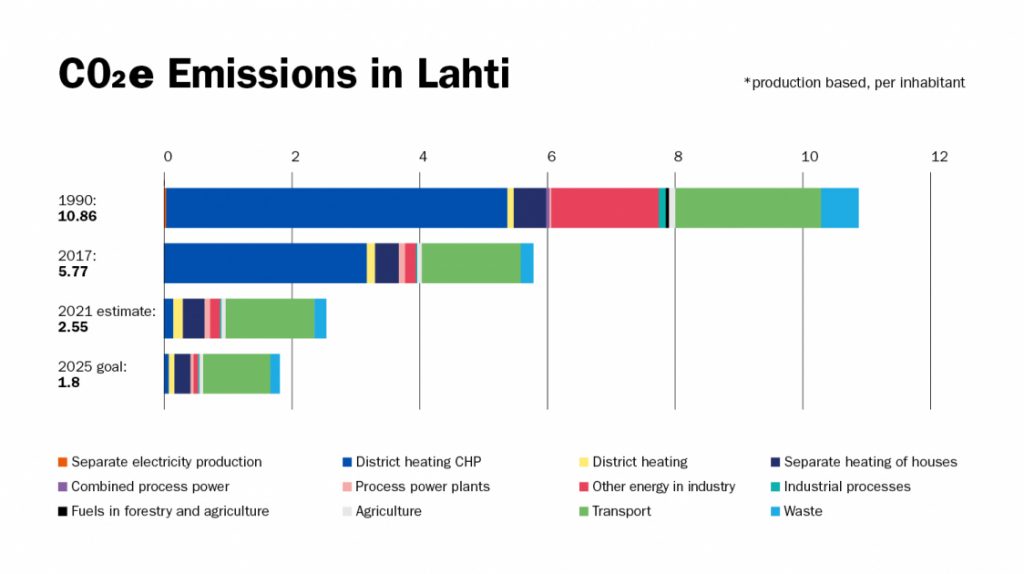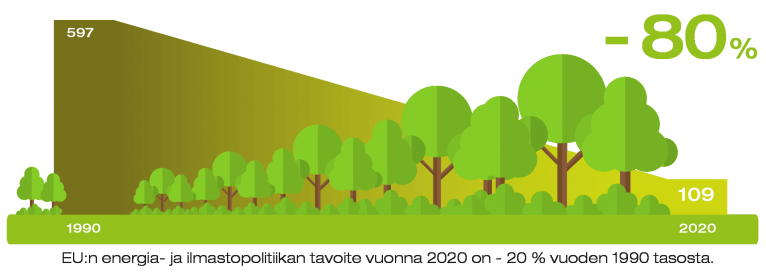Updated on 2021-07-09 by Adam Hardy
In 2017 the Finnish city of Lahti declared they would become carbon-neutral by 2025. Now they must get each citizen to reduce their annual carbon footprint to 1.8 tonnes.
While there are a few important omissions from their carbon footprint data e.g. flights, Lahti has quietly forged ahead in recent years weaving a kind of decarbonisation magic across their landscape, begging the question of why the world talks about a “lost decade” in climate action.
Anna Huttunen is the project manager of the program’s Sustainable Mobility unit, part of the City of Lahti council. I spoke to her on Zoom about how the project is a key part of achieving the 2025 goal.
2025 is now only 4 1/2 years away so unlike many who are using 2050 as a target, they feel a strong sense of immediacy!
In 1990 the average Lahti carbon footprint was 11 tonnes of CO2, and currently it is around 6 tonnes, thanks to some major changes by the city council, such as the phase-out of coal and replacement with a waste incinerator. Now they face the difficult task of reducing the CO2 emissions resulting from citizens’ individual choices.
Petrol consumption is one of them – Lahti has no tram or metro system like Helsinki so their immediate challenge is to encourage as many people as possible out of their cars and onto their bicycles.
To encourage this, the city developed a cap-and-trade smartphone-based carbon rationing and trading scheme.
It is currently in the pilot phase with 1,000 Lahti residents. Each person is allocated a personal carbon allowance for each period and the app detects how (and how far) they travel – bus, car, bicycle – and deducts the carbon from their allowance as they use it.
If they have any allowance left over, the app automatically “sells” it back to the city in return for credits which can be used for city services such as buses, swimming pools, etc. As well as encouraging their users to switch to different modes of transport to save their carbon rations, Lahti is investing heavily in walking and cycling, and focusing on employers to promote the rationing programme to their employees.
Focusing on the Carbon Footprint of a City
Huttunen introduced me to Ville Uusitalo, Assistant Professor at the LUT School of Energy Systems (part of Lappeenranta-Lahti University of Technology). Uusitalo and his colleagues started collaborating in 2017 with the City of Lahti and a group of Finnish tech companies which is developing the smartphone technology that uses AI to detect the user’s mode of transport.
With the timeline of 2025 and the stubborn statistics on car usage, Uusitalo and his fellow LUT researchers were looking for something innovative to encourage people to voluntarily and significantly reduce their carbon footprints. The app technology could figure out what mode of transport people were using, and for how far. It means the participants in the trial just need their smartphones to be switched on to take part.
Since it was all voluntary, they allowed the participants define how the carbon allowances would be allocated. They decided that everybody, no matter who they are, would initially get 21 kg of CO2 per week, plus various allowances for personal circumstances, such as having children or disability.
Their target for the first year is to achieve an average 25% reduction in CO2 emissions from personal transport by the end of 2020.
Interestingly for me being a UK citizen, Lahti’s initial plans for the scheme were based on the UK government’s feasibility studies carried out in 2007-2008 by the Blair’s Labour government. While the government went ahead with the ground-breaking 2008 Climate Change Act, they dropped the carbon rationing plan with the famous quote that it was “a policy ahead of its time”.
The chart below shows the breakdown of transport emissions by year.

Next year, the LUT researchers plan to bring domestic energy use and food consumption into the program. Some of the ideas floating around include tapping into the supermarket loyalty card schemes. The supermarkets already have huge amounts of data on their customers’ buying habits. Again, the approach is simple – find a way to make it easy for the majority of people, and set up the system to encourage it.
One thing that struck me is that there is no mention of offsetting here. (See this Carbon Watchdog article for a neutral overview of offsets). Carbon offsetting is a sticking plaster and Lahti proves you just don’t need them.
I would also like to discover more about their biomass fuel sources for the power stations that replaced their coal-fired generation in 2019.
Forests and forestry are a very hot topic, revolving around whether forests as a source of biomass energy can be sustainable. However Lahti is currently mapping out its regional carbon sinks and carbon sources, so it should become obvious.
Of course there are no airplane or international shipping emissions in the carbon footprints here, but that’s no surprise – Finland is a free country so their citizens are unlikely to want too much interference from their city council. Although the Finnish Green Party is in a ruling coalition, there is also a right-wing populist party that could rollback the city’s efforts overnight, and the other political parties has differing policies. So Huttunen and Uusitalo are keen to prevent the CitiCAP scheme being perceived as an imposition. It will be interesting to see whether they take the route of mandatory participation, or find a way to make voluntary participation rewarding and appealing to a majority of Lahti’s population.
One thing they are happy to promote is that Lahti will be the European Green Capital of 2021.
Related Content
- Personal Carbon Trading: The Economic FundamentalsClimate goals, e.g. keeping global warming within the Paris Agreement 2015 2.0°C limit, require simultaneous action at the level of individual citizens, at local levels, in business and industry, and government. In this country, where high emissions levels are the…
- How A Carbon Currency and Markets can work for Climate JusticeUpdated on 2022-10-07 by Adam Hardy The BBC started this train of thought about a carbon currency recently with an article describing how the world’s wealthiest are at the heart of the climate crisis, and that a new “polluter-elite” have…
- How to Reduce the Carbon Footprint of a City by 25%Updated on 2021-07-09 by Adam Hardy In 2017 the Finnish city of Lahti declared they would become carbon-neutral by 2025. Now they must get each citizen to reduce their annual carbon footprint to 1.8 tonnes. While there are a few…
- Personal Carbon TradingPersonal Carbon Trading or PCT is a mechanism for increasing flexibility and efficiency in a carbon allowance or cap-and-trade scheme. It is a component in our policy for a carbon currency and carbon allowances. Where each participant receives a regular…
- Lahti, Finland – Carbon Rationing in ActionUpdated on 2025-05-17 by Adam Hardy The city of Lahti in Finland is running an experimental personal carbon trading scheme, with voluntary carbon rationing or quotas helping citizens reduce their carbon footprints as part of city-based sustainable transport programme. The…
- ABC Radio Australia podcast on Carbon RationingUpdated on 2021-07-09 by Adam Hardy Had the chance of talking on ABC Australia radio about carbon footprints and carbon rationing on the Future Tense programme, along with a representative from the Finnish city of Lahti where they are running…








